|
January 6
We got up at 4:45, in time to meet
Agneil at 5:15 for the quetzal tour. The resplendent quetzal is a
brilliant green bird with a scarlet breast, a member of the trogon
family. It is about the size of a pheasant, and has a three-foot
long tail. Los Quetzales
Parque Nacional is named for these rare and beautiful birds,
as it is one of the places where you have the best chance of
seeing them.
There was a spot with wild avocado
trees near the road, and the quetzals were known to visit early in
the mornings. We parked by the road and shivered in the crisp
morning air while we waited for the quetzals to come. People from
other lodges arrived, and soon there were over thirty people
there. A pair of these magnificent birds flew in and perched high
on a tree branch right above the road. They were amazing, like
something out of a storybook. The light was still dim, so the
photos do not do them justice.
|
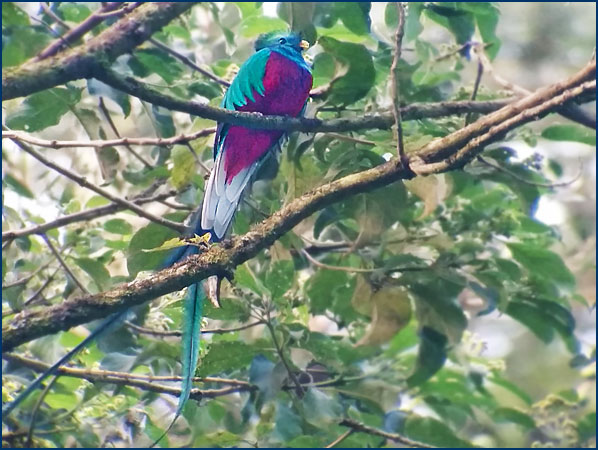
Resplendent Quetzal |
We went back to the Suria lodge for
breakfast, and then set out with Agneil for the Páramo hike. He
drove our little SUV up the crazy steep dirt road out of the
valley. It valiantly chugged its way up; I
think I can, I think I can. No
wonder its transmission sounded like hell and the brakes squealed.
After stopping briefly for some construction, we made it to the
top of the road and turned onto the main highway. Continuing
upward, we took an even steeper little side road to a radio tower
station; there were over twenty towers up on the mountaintop.
We stopped and scrambled up on a
rock outcropping; we were on the continental divide, where on a
clear day one can see both oceans at the same time. We had a good
view of the Pacific to the right of the highway, but it was hazy
on the Caribbean side. We looked down over the valley as a
red-tailed hawk circled below us. We could see the Turrialba
Volcano on the skyline, still spewing forth great clouds of ash
and smoke – in fact it seemed like a lot more than two days
earlier!
|
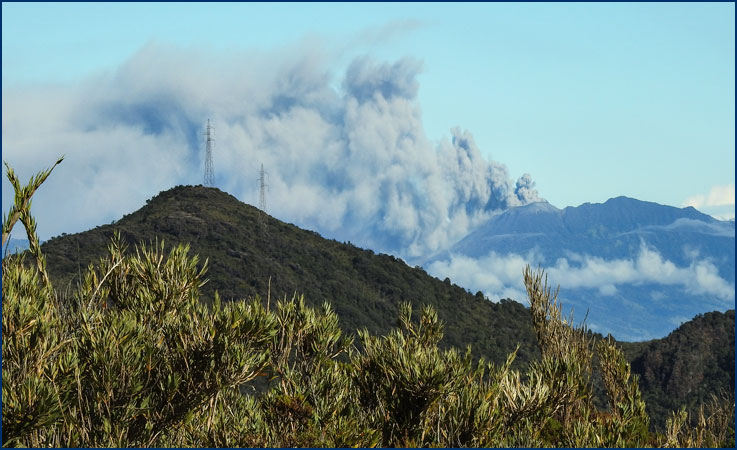
Turrialba Volcano,
erupting in the distance. |
We parked the car on the summit next
to a radio tower and started hiking down the mountainside. The Páramo
is a unique ecosystem of alpine tundra; we
followed the trail down through dwarf trees, bushes and moss.
Agneil told us the elevation here was 3491 meters (11,453 feet),
and oxygen seemed in short supply. It was a clear sunny day, and
the scenery was beautiful. We looked down on the whole of the San
Gerardo de Dota valley before us, with row upon row of green
mountains surrounding it.
|
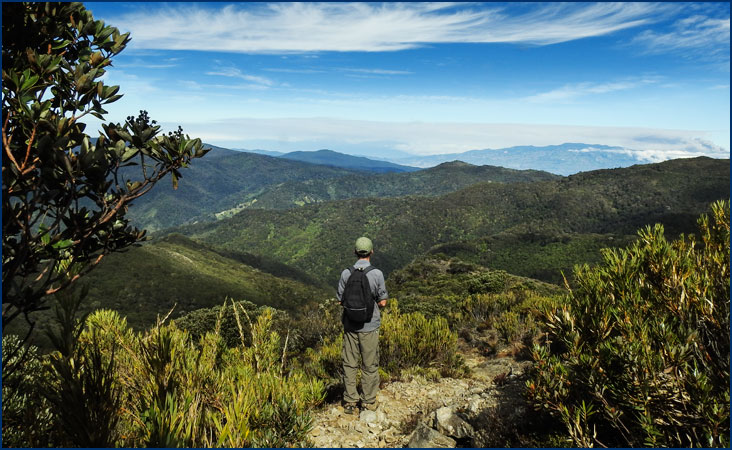
Hiking the
Páramo with Agneil. |
It was cool at this altitude; we even
found ice crystals alongside the trail. The path was steep and
rocky; Agneil leant me his walking stick, which helped a lot. As
steep as the trail was going down, I tried not to dwell on the
fact that we would have to climb up it again. We saw a great many
birds. I particularly enjoyed watching the volcano hummingbirds;
they would fly straight up in the air and then dive-bomb back down
again. Agneil told us about the geology and climate zones of the
area. We hiked down the steep trail for about an hour and a half.
Agneil said that one could hike from the top all the way back down
to the Suria lodge; it sounded great, but it was over 12
kilometers and our knees would never take it.
|
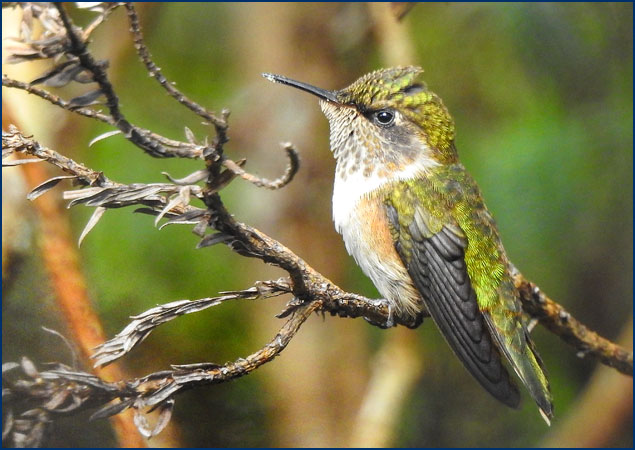
Volcano Hummingbird |
Eventually it was time to head back
up; this was the part I had not been looking forward to. At 3491
meters the air was very thin, and our legs were soon burning with
fatigue. Somehow it seemed even steeper on the way up, and we
stopped every little ways to gasp for oxygen. Clouds started to
roll in and the mist gathered, and before long we could not see
the mountains. Finally, exhausted, we made it to the top.
|
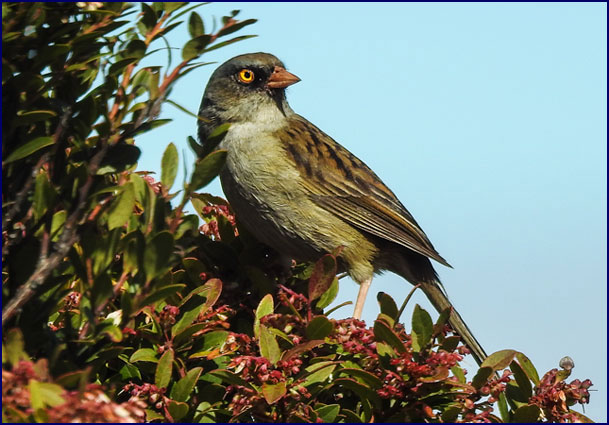
A Volcano Junco, up on the Páramo.
|
Back at the lodge, we spent the
afternoon walking around the grounds and birdwatching. We saw a
great many different types right from our balcony; from tanagers
to woodpeckers, as well as many we could not identify. We checked
out the chicken farm next door; now we knew where our scrambled
eggs in the morning came from. A flock of green parakeets flew
over several times, chattering noisily. Lizards were sunning
themselves on our deck; we counted eight of them. We met a young
Dutch couple, Hidda and Rene, who had moved in to the cabin next
door; we didn’t tell them that Manuel had given us their
heater!
|
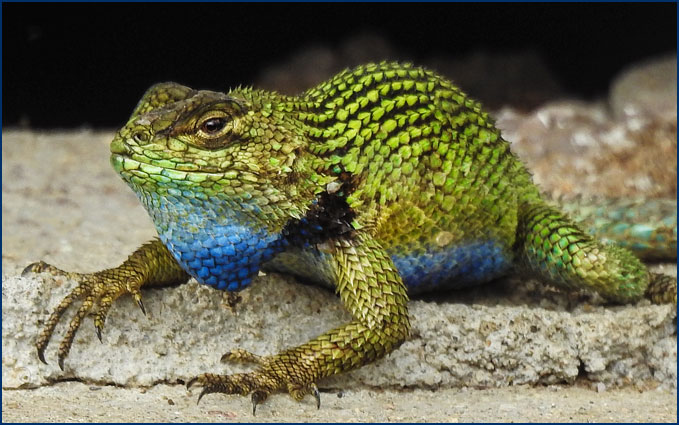
The lizard on our deck.
|
After dinner (trout again) I brought
my little computer tablet to the lounge area to check my email,
and while I was on the internet I did a bit of research. It turned
out that the Turrialba Volcano was actually having a major
eruption, and it was quite a big deal. Apparently it had been
spewing great clouds of ash down on San Jose and the entire
Central Valley for several days, closing the airport and putting
the area into a state of emergency. And we were there to see it!
January
7
Our alarm went off at 4:45; we had
signed up for the quetzal tour again . . . it had seemed like a
good idea at the time. But once we were up and out there we were
glad; this time it was less crowded, and we got to see the
quetzals again, as well as a green toucanet. The male quetzal flew
out of the tree and up the hillside, low over the fields, his
iridescent green feathers shining in the sun and his three-foot
tail trailing behind him. He reminded me of Dumbledore’s phoenix
in the Harry Potter movies.
|
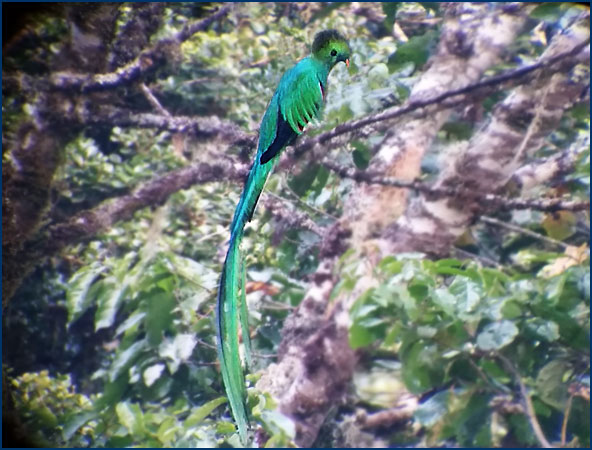
Resplendent Quetzal |
Joined by the Dutch couple, Hidda and
Rene, we went on an all-day birdwatching tour with Agneil. We
started out walking around the hotel grounds and lawn, with Agneil
identifying many of the mystery birds we had seen the previous
afternoon. Jineen took notes on each bird we saw, while I tried to
get photos of as many as I could. Often we used the photos to
identify the birds later, with the help of the bird guide.
|
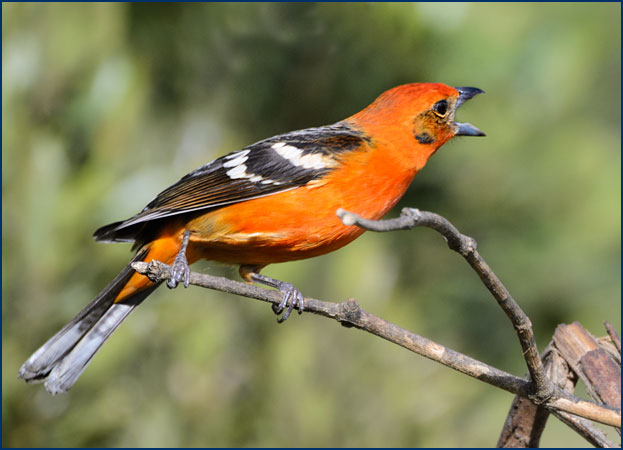
Flame-colored
Tanager, male. |
Next we drove down the hill and
parked by the road, then walked along beside the river to the
start of the waterfall trail. We moved slowly and stopped often to
look at birds; with legs still tired from the Páramo hike this
was somewhat of a relief. Agneil pointed out dozens of birds we
hadn’t seen before; among our favorites were the torrent
tyrantulets, a pair of little grey birds building a nest right
down next to the rushing stream. We watched a magnificent
hummingbird gathering lichens to make a nest, and further on
Agneil showed us a hummingbird nest, high up on a branch, nearly
invisible to the eye.
|
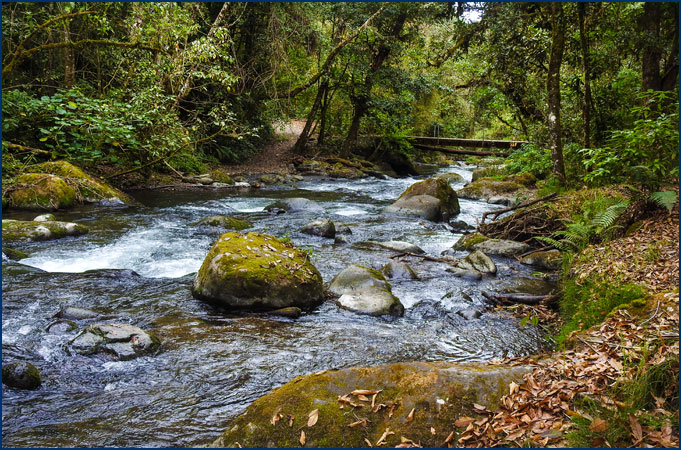
Along the Waterfall Trail
|
On the waterfall trail we saw an
older couple with a scope, birdwatching, and they excitedly
gestured us over to them. They had found quetzals! But as we
approached they flew away. It is very unusual to see quetzals
while out hiking; we were sorry to have missed them. We scanned
the trees with our binoculars, hoping for a glimpse of the
brilliant birds. We had all but given up when Hidda casually said
“quetzals”, and sure enough there they were, perched up in the
tree! Had they been there all the time, or had they left and come
back? We watched them for a while, and then moved off quietly so
as to not disturb them.
We
hiked on to a clearing in the forest above the stream; there was a
‘for sale’ sign, and
Agneil commented that it would be a very beautiful spot for a
house, but there was no road to it. Heading back toward the car,
we met two hikers at a fork in the trail, and they had an animated
conversation in Spanish with Agneil. They had found a trogon nest!
Following their
directions, we climbed up the other trail and soon located the
nest; this was a really rare find. A female trogon with a red
breast sat on a branch, and the male was inside a hole in the
tree, ‘working’ the nest, scouring out wood to enlarge it. We
were very lucky to get the chance to watch them.
|
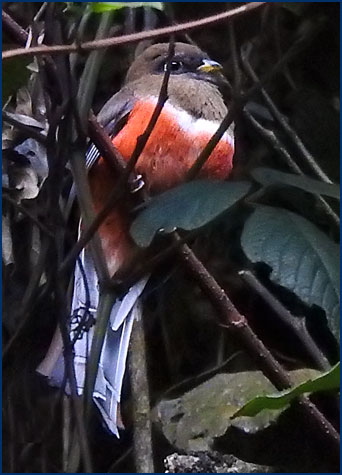
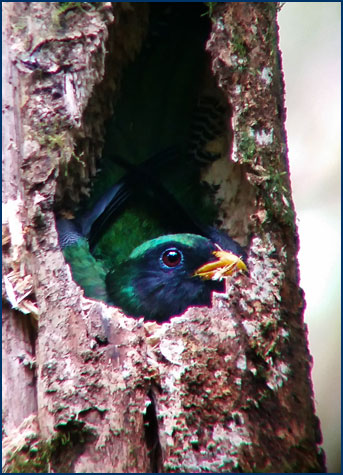
Trogons |
Back at the lodge we had lunch on our
balcony. We watched the hummingbirds hover above the flowers. An
elusive little dark grey bird flitted among the shrubs; earlier
Agneil had identified it as a flower-piercer, and we watched it
poke its long hooked bill through the blossoms to feed.
The parakeets flew by again, but this time they landed in a
big tree down on the lawn. I got a quick look at them through the
binoculars before they took off - they were beautiful! I wished
they would linger long enough for me to get a photo.
|
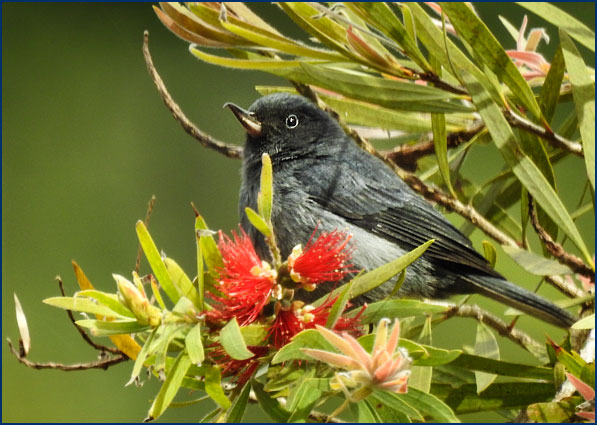
Flower-piercer
|
After lunch Agneil drove us up the
road to the top of the valley. Once again we found the road closed
for maintenance; it looked like it might be a long wait, but since
they knew Agneil they let us squeeze through with instructions to
be careful. Sure enough, we soon met a huge road grader and had to
pull half off the road to let him through, our car practically
hanging over the edge of a precipice. I looked straight down at
the valley below. ‘Hey
Agneil, you do realize there is a thousand-foot drop-off on this
side, right?’
It seemed that the road closures
were a pretty regular thing; on any given day one might have to
wait 3 minutes or 3 hours. Maintaining and repairing that road
must be a constant year-round job for a road crew. Really,
considering the steepness of the mountain, it is nothing short of
amazing that the road could be built in the first place.
Our destination was a little café
called Miriam’s (or possibly Mirian’s, depending on which sign
you read), where there was a balcony porch with birdfeeders. This
was a great spot for some bird photography; I had been frustrated
the last two days taking a lot of bad bird photos with too much
zoom and not enough light, so it was great to get a chance for
some close-ups.
|
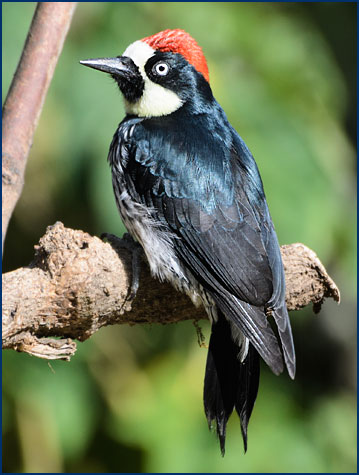
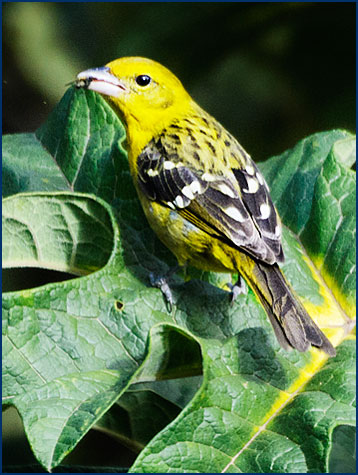
An Acorn Woodpecker, and a female Flame-colored Tanager. |
Among the highlights were flame-colored tanagers (the males are
bright red and the females yellow), yellow-thighed finches (mostly
black with ridiculous yellow spots on their legs) and acorn
woodpeckers (black and white with a red top on their head and
eerie white eyes). We also had a good look at a nice looking but
very plain brown bird which Agneil identified as the clay-colored
thrush; we learned to our surprise that this is the national bird
of Costa Rica! Not what one might have expected.
|
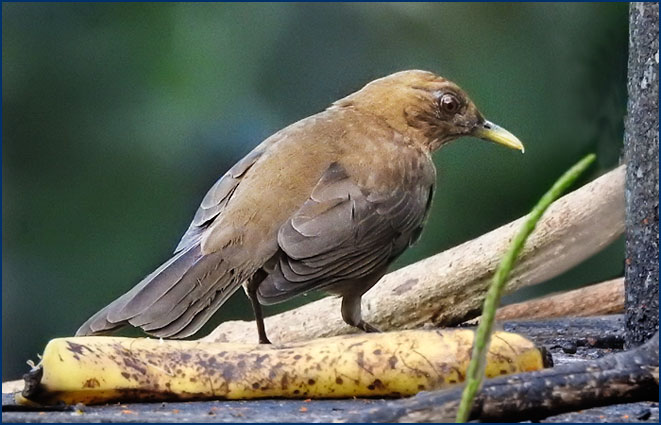
Clay-colored Thrush, the national bird of Costa
Rica. |
Agneil pointed his scope at a distant
plum tree where a small neon green and yellow bird could be seen
eating the fruit. This rare bird was a golden-browed chlorophonia,
and was Agneil’s main reason for bringing us there. Though
brilliantly colored, it was small and far away, and could only be
seen through the scope; I was more interested in photographing the
birds close by at the feeder.
|
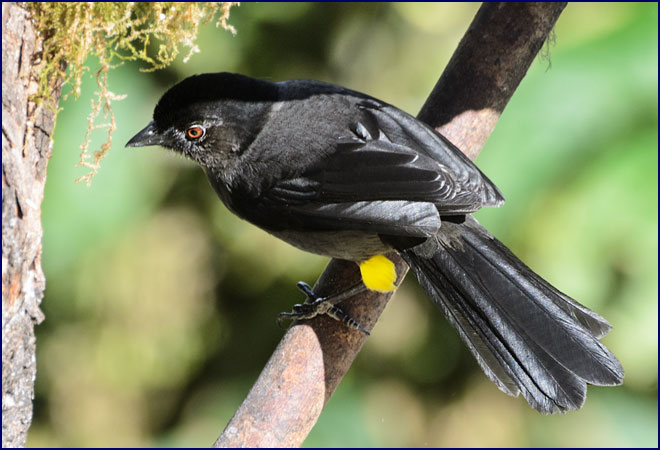
Yellow-thighed finch |
Presently the others were ready to
leave, but the woman directing the road construction traffic told
us we had to wait for the four big gravel trucks to come back up
from the valley. I was happy to have more time for bird
photography at the feeder. Finally the four trucks had rumbled by
– we could hear them coming a mile away – and we headed down.
We soon found out there was a fifth truck; it was a very tight
squeeze getting by it.
We stopped by the Trogon
Lodge to look for skimmers along the Savegre River; we didn’t
see any so I never found out what they are. It was a beautiful
stream, cascading down across the lawn and under a bridge. A
torrent tyrantulet flitted around on the rocks in the spray.
Passing the spot where we were held
up the first day for road construction, we stopped to look for
woodpeckers, but no luck. We noticed that where the culvert had
been replaced, the side of the road was treacherously crumbling
away. A bit further on we climbed up a short steep trail to a
grove of avocado trees; it was a lovely view but there were no
notable birds around, so Agneil took us back to the Suria. Jineen
and I had happy hour on our balcony, dined at the restaurant and
then went to bed early. Jineen was sad because she had finished
her book and had nothing to read.
This was our last night at the Suria;
we had really enjoyed our stay, and had found the bird-watching
very rewarding. I vowed to start paying more attention to
identifying our birds at home! We knew we would miss this place,
and Agneil.
|